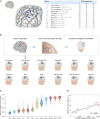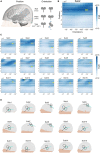Targeting the pathological network: Feasibility of network-based optimization of transcranial magnetic stimulation coil placement for treatment of psychiatric disorders
- PMID: 36685239
- PMCID: PMC9846047
- DOI: 10.3389/fnins.2022.1079078
Targeting the pathological network: Feasibility of network-based optimization of transcranial magnetic stimulation coil placement for treatment of psychiatric disorders
Abstract
It has been recognized that the efficacy of TMS-based modulation may depend on the network profile of the stimulated regions throughout the brain. However, what profile of this stimulation network optimally benefits treatment outcomes is yet to be addressed. The answer to the question is crucial for informing network-based optimization of stimulation parameters, such as coil placement, in TMS treatments. In this study, we aimed to investigate the feasibility of taking a disease-specific network as the target of stimulation network for guiding individualized coil placement in TMS treatments. We present here a novel network-based model for TMS targeting of the pathological network. First, combining E-field modeling and resting-state functional connectivity, stimulation networks were modeled from locations and orientations of the TMS coil. Second, the spatial anti-correlation between the stimulation network and the pathological network of a given disease was hypothesized to predict the treatment outcome. The proposed model was validated to predict treatment efficacy from the position and orientation of TMS coils in two depression cohorts and one schizophrenia cohort with auditory verbal hallucinations. We further demonstrate the utility of the proposed model in guiding individualized TMS treatment for psychiatric disorders. In this proof-of-concept study, we demonstrated the feasibility of the novel network-based targeting strategy that uses the whole-brain, system-level abnormity of a specific psychiatric disease as a target. Results based on empirical data suggest that the strategy may potentially be utilized to identify individualized coil parameters for maximal therapeutic effects.
Keywords: brain network; electric field calculation; individualized treatment; psychiatric disorder; transcranial magnetic stimulation.
Copyright © 2023 Cao, Xiao, Zhao, Jiang, Xie, Paillère-Martinot, Artiges, Li, Daskalakis, Yang and Zhu.
Conflict of interest statement
The authors declare that the research was conducted in the absence of any commercial or financial relationships that could be construed as a potential conflict of interest.
Figures






Similar articles
-
Personalized connectivity-based network targeting model of transcranial magnetic stimulation for treatment of psychiatric disorders: computational feasibility and reproducibility.Front Psychiatry. 2024 Feb 14;15:1341908. doi: 10.3389/fpsyt.2024.1341908. eCollection 2024. Front Psychiatry. 2024. PMID: 38419897 Free PMC article.
-
Proof of concept study to develop a novel connectivity-based electric-field modelling approach for individualized targeting of transcranial magnetic stimulation treatment.Neuropsychopharmacology. 2022 Jan;47(2):588-598. doi: 10.1038/s41386-021-01110-6. Epub 2021 Jul 28. Neuropsychopharmacology. 2022. PMID: 34321597 Free PMC article.
-
TAP: targeting and analysis pipeline for optimization and verification of coil placement in transcranial magnetic stimulation.J Neural Eng. 2022 Apr 21;19(2):10.1088/1741-2552/ac63a4. doi: 10.1088/1741-2552/ac63a4. J Neural Eng. 2022. PMID: 35377345 Free PMC article.
-
Controversy: Repetitive transcranial magnetic stimulation or transcranial direct current stimulation shows efficacy in treating psychiatric diseases (depression, mania, schizophrenia, obsessive-complusive disorder, panic, posttraumatic stress disorder).Brain Stimul. 2009 Jan;2(1):14-21. doi: 10.1016/j.brs.2008.06.001. Epub 2008 Jun 27. Brain Stimul. 2009. PMID: 20633399 Review.
-
Systematic numerical assessment of occupational exposure to electromagnetic fields of transcranial magnetic stimulation.Med Phys. 2022 May;49(5):3416-3431. doi: 10.1002/mp.15567. Epub 2022 Mar 13. Med Phys. 2022. PMID: 35196394 Free PMC article. Review.
Cited by
-
Optimizing TMS Coil Placement Approaches for Targeting the Dorsolateral Prefrontal Cortex in Depressed Adolescents: An Electric Field Modeling Study.Biomedicines. 2023 Aug 21;11(8):2320. doi: 10.3390/biomedicines11082320. Biomedicines. 2023. PMID: 37626817 Free PMC article.
-
Personalized connectivity-based network targeting model of transcranial magnetic stimulation for treatment of psychiatric disorders: computational feasibility and reproducibility.Front Psychiatry. 2024 Feb 14;15:1341908. doi: 10.3389/fpsyt.2024.1341908. eCollection 2024. Front Psychiatry. 2024. PMID: 38419897 Free PMC article.
-
Electric Field Modeling in Personalizing Transcranial Magnetic Stimulation Interventions.Biol Psychiatry. 2024 Mar 15;95(6):494-501. doi: 10.1016/j.biopsych.2023.11.022. Epub 2023 Dec 5. Biol Psychiatry. 2024. PMID: 38061463 Free PMC article. Review.
References
-
- Anna Manelis P. D., David A. A., Baranger P. D., Skye Satz B. S., Rachel Ragozzino M. A., Satish Iyengar P. D., et al. (2021). Data from cortical myelin measured by the T1w/T2w ratio in individuals with depressive disorders and healthy controls. OpenNeuro. 10.18112/openneuro.ds003653.v1.0.0 - DOI - PMC - PubMed
-
- Balderston N. L., Beer J. C., Seok D., Makhoul W., Deng Z., De, et al. (2021). Proof of concept study to develop a novel connectivity-based electric-field modelling approach for individualized targeting of transcranial magnetic stimulation treatment. Neuropsychopharmacology 47 588–598. 10.1038/s41386-021-01110-6 - DOI - PMC - PubMed
LinkOut - more resources
Full Text Sources

